Amd Installer Cannot Continue Digitally Signed
The browser version you are using is not recommended for this site.
Please consider upgrading to the latest version of your browser by clicking one of the following links.
- Safari
- Chrome
- Edge
- Firefox
How to Install Radeon™ Software on a Windows® Based System
Documentation
Install & Setup
000028813
06/10/2022
This article provides instructions on how to install Radeon™ Software on a Windows® based system.
System Requirements
For information about the system requirements please refer to the Radeon Software release notes posted on the driver download page. System requirements may vary depending on the version of Windows® operating system installed.
Downloading Radeon Software
Radeon Software is available at AMD Drivers + Download Center. The site provides two options to locate and download the latest version of the Radeon Software:
- Automatically Detect and Install Your Driver: Run the AMD Driver Auto-Detect Tool to detect your Radeon™ graphics product and Windows® operating system. If your graphics card and Windows® version are compatible with Radeon Software, the tool will provide the option to download it. More information on using AMD Driver Auto-detect Tool, please see KB article: Obtaining Graphics Drivers Using the AMD Driver Auto-Detect Tool.
- Manually Select Your Driver: Use the AMD Product Selector to choose your Radeon™ graphics product and available drivers. More information on using the AMD Product Selector, please see KB article: How to Find the Latest Compatible Drivers for an AMD Graphics Product.
Installing Radeon Software
Ensure that any existing AMD graphics driver on the system is removed before installing a new driver package. Performing a complete uninstall ensures a clean system and can help reduce issues or conflicts that may occur on new installations.
For instructions on how to uninstall AMD graphics drivers please refer to KB article: How to Uninstall Radeon Software from a Windows Based System
| Note | Close all opened applications including anti-virus, firewall, remote-access, or webcam software before attempting the install process. |
Once the Radeon Software package has been downloaded, run the executable file to begin the installation.
The End User License Agreement will be presented at the start. Review the End User License Agreement and information about the User Experience Improvement Program.

If you agree to the terms, select either Accept and Express Install or Accept and Custom Install to move on to the next stage of installation or click on X to quit and exit to the Desktop.
Accept and Express Install – Installs only default components included in the driver package. Radeon ReLive and other optional components are not installed.
Accept and Custom Install – Provides a list of core and optional components included in the driver package and allows the user to manually select items to be included in the installation. Radeon ReLive install option will be presented for eligible systems near the end of the installation process.
Once the installation begins, the AMD Software Installer will attempt to detect your AMD graphics product.
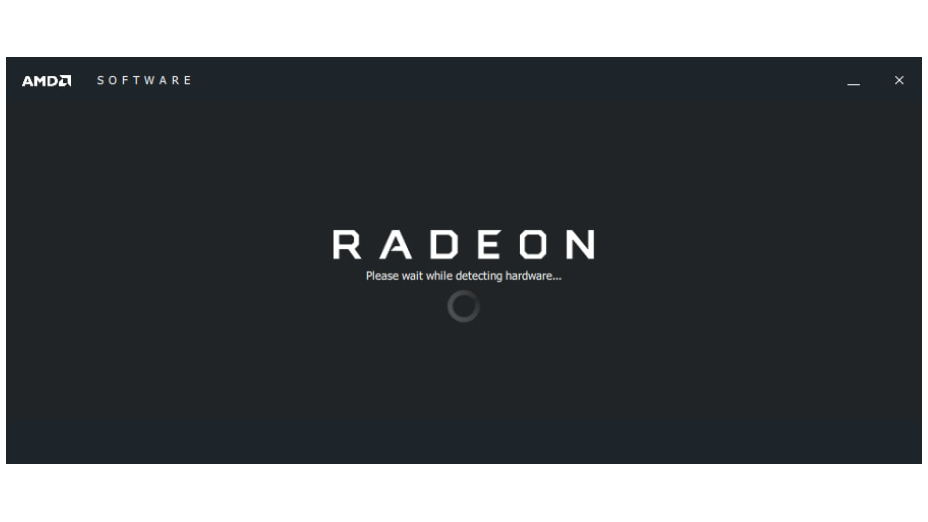
After the detection phase is complete, the following screens and prompts presented will be based on the selected installation type.
Express Install
This installation type should install all core software and driver components in the default folder location, C:\Program Files\AMD\. The installation process begins immediately after selecting Accept and Express Install and requires minimal user interaction.

| Note | The display(s) may flicker and/or lose image briefly during installation. This is expected behavior and image will be restored once installation is complete. |
For Radeon ReLive eligible systems, the Install Radeon ReLive option screen will not be presented when using Express Install. Instead, the Radeon ReLive package are copied to the Radeon Settings folder and can be installed at a later time. For more information about Radeon ReLive, please refer to KB article: How to Install and Enable Radeon ReLive
Once the installation has successfully completed, the final screen should provide Restart Now and/or Close options, as shown in the example below:

Restart Now will restart the system and Close will exit to the Desktop. If system restart is not required, then only the Close option will be available.
If one or more components were not installed or the installation was interrupted, the final screen should provide the options shown in the example below:
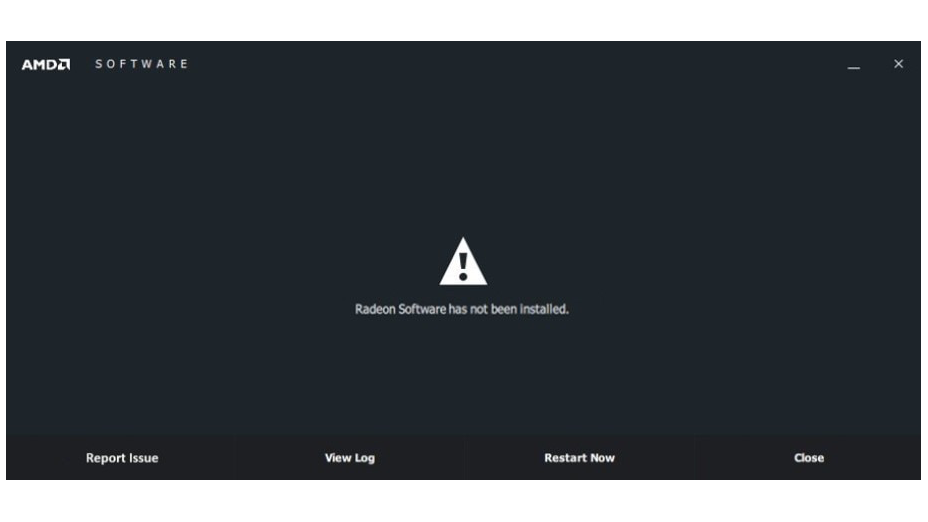
Report Issue opens the AMD Issue Reporting Form using the default web browser. The AMD Issue Reporting Form can be used to provide feedback on the installation issue. The system must be connected to the internet otherwise, the page will not be displayed.
View Log opens the installation log file (Report.xml) using the default web browser. The log file contains details about the graphics hardware and software components installed. The Report.xml file can also be found in the folder: C:\Program Files\AMD\CIM\Reports\
Restart Now will restart the system and Close will exit to the Desktop. If system restart is not required, then only the Close option will be available.
Custom Install
This installation type provides the option to specify the individual components and the location where they are to be installed.
After selecting Accept and Custom Install, the Installer should begin checking for any Radeon Software that is currently installed in the system and one of the following two scenarios should occur:
- The Installer detected a version of Radeon Software is currently installed and displays a screen like the example below:
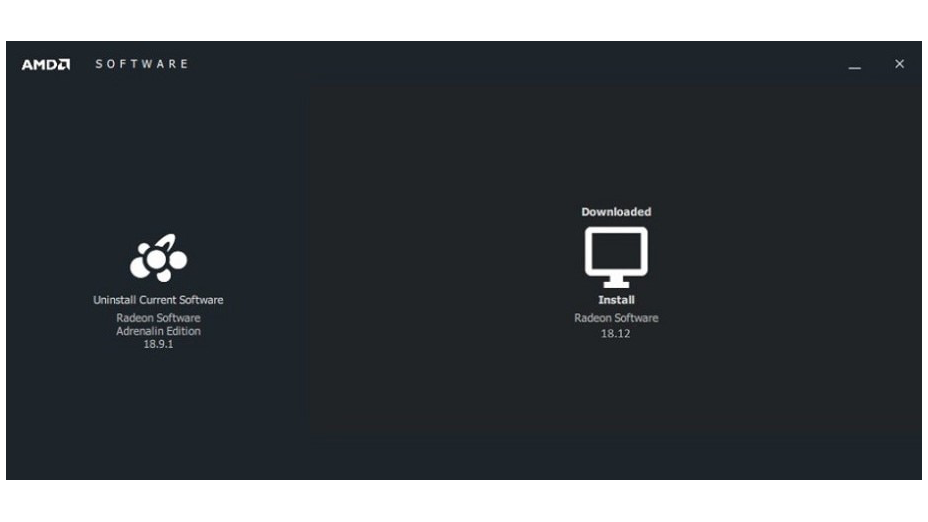
Selecting Uninstall Current Software should open a menu providing the following choices:

Express Uninstall – Automatically uninstalls all components of the currently installed Radeon Software package.
Custom Uninstall – Allows selecting individual components to be uninstalled.
Search for Legacy Drivers – Opens the AMD Drivers and Support page where older driver versions can be obtained.Note These are optional choices. The installation of the downloaded Radeon Software package will not continue after Express Uninstall or Custom Uninstall has completed. To continue installing the downloaded Radeon Software package, please rerun the executable file. To install the downloaded Radeon Software package, select Install Radeon Software (version), and click Install:
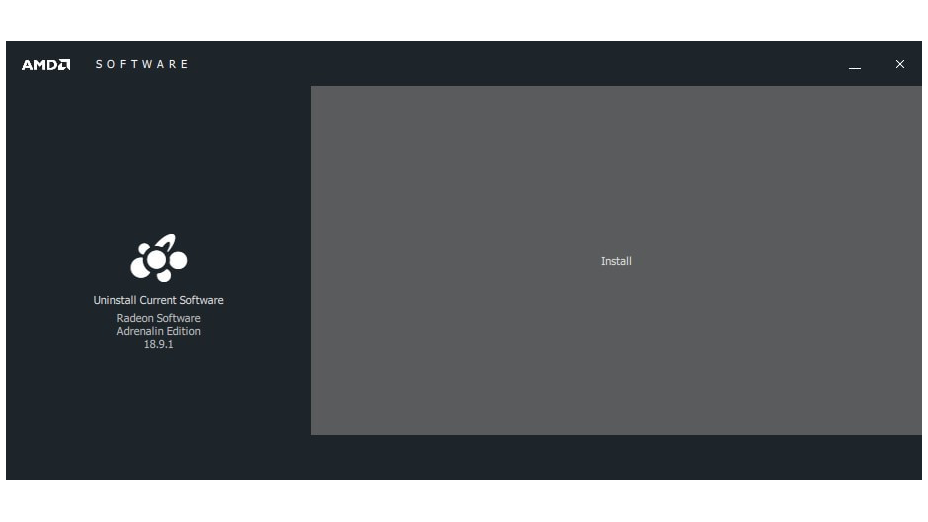
- The Installer did not detect any installed version of Radeon Software and displays a screen like the example below:
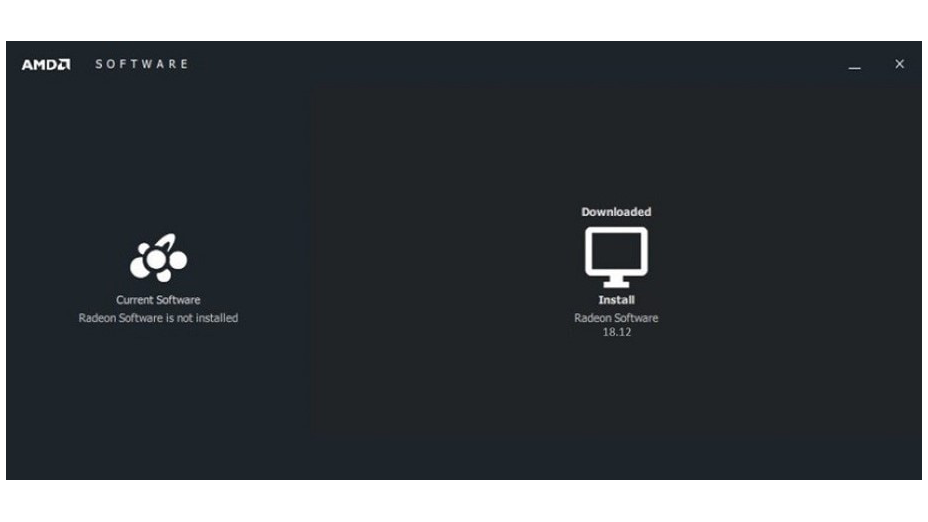
To install the downloaded Radeon Software package, select Install Radeon Software (version), and click Install:

After clicking Install, the following screen will display the destination folder and components for installation, as shown in the example below:

Note It is recommended to use the default destination folder for installation. If another version of Radeon Software is installed and detected during the previous step, a Clean Install option will be available on the Custom Install screen, as shown below.

Clean Install attempts to remove all detected versions of Radeon Software and AMD drivers from the system before installing the selected components. This prevents rolling back to a previously installed driver version (via Device Manager) but can help resolve some common corrupted driver installation problems.
Note Since the system will be forced to reboot as part of Clean Install process, make sure to save your work before proceeding. After the system has rebooted, the installation should continue automatically. Near the end of the installation, a screen providing the option to install Radeon ReLive should appear for eligible systems, as shown in the example below:
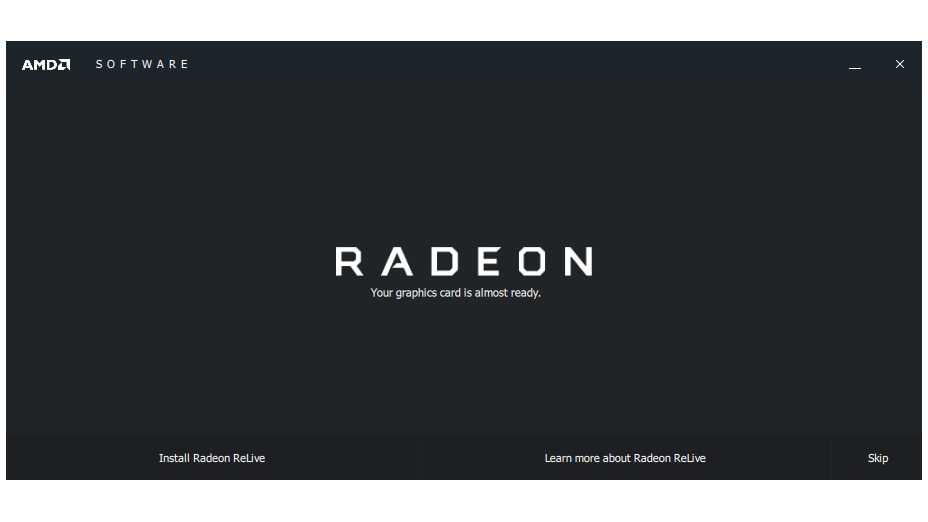
Note Radeon ReLive is only available on eligible systems. For more information about Radeon ReLive please refer to KB: How to Install and Enable Radeon ReLive(URL: https://www.amd.com/en/support/kb/faq/relive-install) Once the installation has completed successfully, the final screen should provide Restart Now and/or Close options, as shown in the example below:
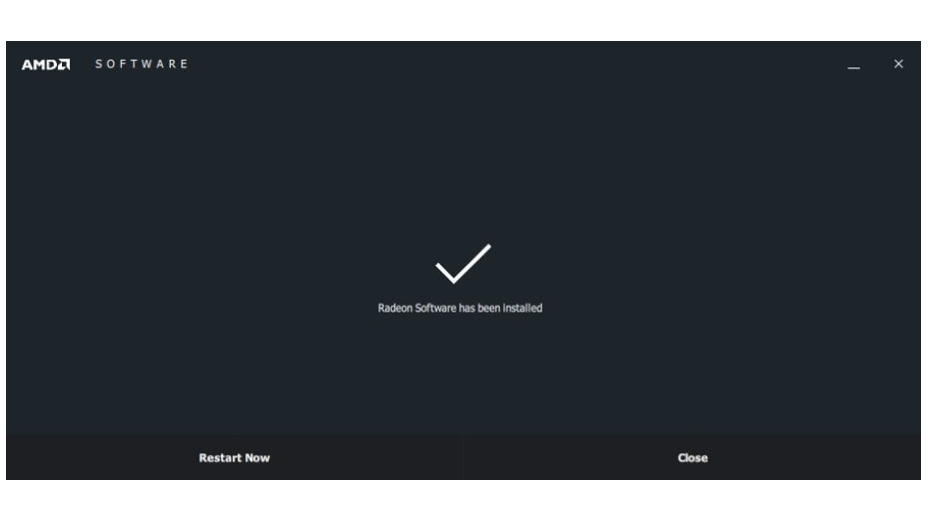
Restart Now will restart the system and Close will exit to the Desktop. If system restart is not required, then only the Close option will be available.
If one or more components were not installed or the installation was interrupted, the final screen should provide the options shown in the example below:

Report Issue opens the AMD Issue Reporting Form(URL: http://www.amd.com/report) using the default web browser. The AMD Issue Reporting Form can be used to provide feedback on the installation issue. The system must be connected to the internet otherwise, the page will not be displayed.
View Log opens the installation log file (Report.xml) using the default web browser. The log file contains details about the graphics hardware and software components installed. The Report.xml file can also be found in the folder: C:\Program Files\AMD\CIM\Reports\
Restart Now will restart the system and Close will exit to the Desktop. If system restart is not required, then only the Close option will be available.
Potential Errors and Solutions
If the Installer encountered a problem during the detection, download and/or installation phase, one of the following messages may be displayed:
- Error 1603 – A General Error Has Occurred During the Installation of the AMD Software Package
- Error 182 – AMD Installer Cannot Properly Identify the AMD Graphics Hardware
- Error 183 – AMD Installer Cannot Continue Due to Third Party Graphics Drivers Installed
- Error 184 – AMD Installer Cannot Continue Due to Unsupported an Operating System
- Error 173 – AMD Installer Cannot Continue Since AMD Graphics Hardware Was Not Found
- Error 174 – AMD Installer Cannot Continue Due to an Unsupported AMD Graphics Hardware Configuration
- Error 175 – AMD Installer Cannot Continue Due to Unsupported AMD Graphics Hardware
- Error 192 – AMD Installer Cannot Continue Due to an Operating System Issue
- Error 176 – AMD Installer Cannot Continue Due to Insufficient Disk Space
- Error 186 – AMD Installer Cannot Continue Due to Missing or Corrupted Manifest Files
- Error 98 – AMD Installer Cannot Continue Because Driver Files are Missing
- Error 99 – AMD Installer Cannot Continue Because the Driver has not Been Digitally Signed
- Error 193 – AMD Installer Cannot Continue Due to Missing or Corrupted Files
- Error 194 – AMD Installer Cannot Continue Because It Was Unable to Load Required Files
- Error 195 – AMD Installer Cannot Continue Since It Cannot Access the Required Web Resources
- Error 196 – AMD Installer Cannot Continue Since It Cannot Download the Driver Package
When any one of the above errors occur, the Installer cannot continue further until the issue is resolved. For information about an error and recommended solution(s), please click on its link above to view the associated KB article.
* Intel is supplying content from third-party sites for your convenience and may supply links to additional third-party site(s). Providing such content and/or links only constitutes suggestions and should not be mistaken as an endorsement or recommendation for any specific action. Performing actions recommended by third-party vendors can result in improper operation, damage to the board or processor, or reduced product life. Intel assumes no liability whatsoever in connection with your use of third-party sites or material and disclaims any express or implied warranty relating to the third-party sites or materials. Intel does not control or audit third-party materials or the third party websites referenced. You should visit the referenced website and confirm whether referenced data is accurate.
Related Products
This article applies to 2 products.
Need more help?

Give Feedback
wisemanparminquale.blogspot.com
Source: https://www.intel.com/content/www/us/en/support/articles/000028813/graphics.html